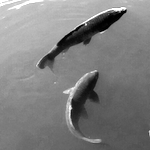Although planktonic organisms drift with the water flows, by definition, they exhibit active behaviors beyond mere drifting. Despite their millimetric size, many of these organisms can actively swim and perceive their surrounding flow using mechanosensory hairs. This raises the question of the practicality of flow sensing in a turbulent environment. To explore this question, we present two possible instances of apparently intelligent planktonic behavior.
First, we propose a model that demonstrates how planktonic organisms can strategically select their swimming direction based on the velocity gradient of the surrounding flow. This behavior allows them to effectively 'surf on turbulence'. By exploiting the inherent properties of turbulence, these organisms could efficiently navigate in an upward direction, thus providing an evolutionary advantage.
Second, we investigate how planktonic organisms can use velocity gradient measurements to track the position of swimming targets. This mechanism enables the planktonic organisms to detect and locate other organisms in their vicinity, by 'triangulating' their hydrodynamic signatures
By presenting these two examples of possible intelligent planktonic behavior, not only do we get insight into the remarkable capabilities of these organisms, but we also offer potential insights into bio-inspired approaches for engineering autonomous systems.

 PDF version
PDF version
